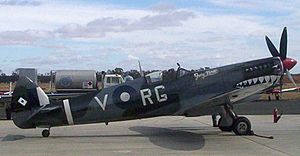Spitfire Mk.IX
| Spitfire | |
|---|---|
 |
|
| A restored Supermarine Spitfire VIII, A58-758, in the colours and markings of Wg. Cdr Bobby Gibbes of 80 Wing RAAF, based on Morotai in 1945. | |
| Role | Fighter / Photo-reconnaissance |
| Manufacturer | Supermarine |
| Designer | Joseph Smith |
| First flight | September 1941 (Mk III with Merlin 61) |
| Introduction | June 1942 (Mk IX) |
| Retired | 1955, RAF |
| Primary user | Royal Air Force |
| Produced | 1942–1945 |
| Number built | 8,996 (20,346 total) |
| Variants | Seafire, Spiteful, Seafang |
The British Supermarine Spitfire was facing several challenges by mid-1942. The debut of the formidable Focke-Wulf Fw 190 in late 1941 had caused problems for RAF fighter squadrons flying the latest Spitfire Mk Vb. By this time Rolls-Royce engineers were already working on a new version of the Merlin incorporating a two-stage supercharger; the combination of the improved Merlin and the Spitfire Mk VC airframe in a "stop-gap" design allowed the RAF to combat the Fw 190 on equal terms. In a second stream of development Supermarine was working on an improved, reinforced, Spitfire airframe which incorporated several new features and was designed specifically for the Merlin 60 and 70 series engines. This new airframe later formed the basis for the Rolls-Royce Griffon powered Spitfires.
This article presents a history of the Spitfire powered by two-stage engine variants and also describes some of the "drawing board" projects and experimental Spitfires. The Griffon powered variants are described in a separate article.
The majority of the Spitfires from the Mk VIII on, used three basic wing types; C, D and E
Also known as the "universal wing" the new design was standard on the majority of Spitfires built from mid 1942. This wing was structurally modified to reduce labour and manufacturing time and it was designed to allow mixed armament options: A type, B type, or four 20 mm Hispano .
The undercarriage mountings were redesigned and the undercarriage doors were bowed in cross section allowing the legs to sit lower in the wells, eliminating the upper-wing blisters over the wheel wells and landing gear pivot points. Stronger undercarriage legs were raked 2 inches (5.08 cm) forward, making the Spitfire more stable on the ground and reducing the likelihood of the aircraft tipping onto its nose. During production of the Mk VIII and Mk IX a new undercarriage leg was introduced which had external v-shaped "scissor-links" fitted to the front of the leg; this also led to small changes in the shape of the undercarriage bay and leg fairings. Because the Spitfire was no longer to be used as a night fighter, the retractable landing lights were no longer fitted.
The Hispano Mk IIs were now belt fed from box magazines allowing for 120 rpg (the "Chattellerault" system). The fairings over the Hispano barrels were shorter and there was usually a short rubber stub covering the outer cannon port. Redesigned upper wing gun bay doors incorporated "teardrop" shaped blisters to clear the cannon feed motors, and the lower wings no longer had the gun bay heating vents outboard of the gunbays. The first series of Spitfire Mk IXs retained the bay doors first used on Spitfire VCs; these incorporated large blisters to clear the feed motors of two Hispano cannons. All later Spitfires had smaller, more streamlined blisters. In order to provide room for the belt feed system of the cannon, the inner machine gun bays were moved outboard to between ribs 13 and 14.
...
Wikipedia
